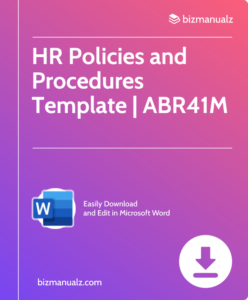What Are The Best Practices For An Employee Policy Procedure Manual?

A comprehensive employee policy procedure manual is essential for any organization. It helps set clear employee guidelines and expectations, promote fairness and compliance in the workplace, and give employees a reference point for their rights and responsibilities. What Are The Best Practices For An Employee Policy Procedure Manual?
Get Practices For An Employee Policy Procedure Manual
When creating a manual, several key factors must be considered. First, it should be tailored to the organization’s unique needs and objectives. This makes sure the policies fit the company culture and its goals, as well as any legal requirements or industry standards.
Second, the manual should be written in simple language. Complex jargon and unnecessary vocabulary should be avoided to maximize comprehension and minimize confusion.
Third, include real-life examples and scenarios. This helps employees gain a better understanding of how policies are applied in practice and encourages them to follow the rules.
For example, a documented policy procedure saved a manufacturing firm from legal repercussions. An employee was injured due to not following safety procedures.
But, due to the well-defined policy manual, it was clear that proper measures were not taken. This documentation served as proof that the company followed the rules, protecting them from being held liable.
Importance of an Employee Policy Procedure Manual
An Employee Policy Procedure Manual is essential for any organization. It serves as a thorough guide for employees, laying out the company’s policies and procedures. This manual ensures uniformity and consistency in employee practices, providing a solid base for operations.
- Clear Communication: The manual is a great way to impart expectations and obligations between employer and employee, reducing any misunderstandings or confusion.
- Legal Compliance: The manual must be up-to-date to ensure compliance with laws and regulations. It helps minimize legal risks by offering guidelines on how to manage different scenarios, like harassment complaints or safety protocols.
- Consistency & Fairness: By specifying policies, the manual helps make decisions uniformly, ensuring fair treatment of employees. This encourages a positive work atmosphere based on equality and openness.
- Onboarding & Training: A comprehensive manual helps new employees adjust, informing them of the company culture, expectations, and values. It’s also a great training resource, decreasing dependence on individual knowledge transfer.
It is important to always keep the Employee Policy Procedure Manual current and available to all workers for top performance.
Moreover, I remember a case where an organization dealt with legal repercussions due to not having an up-to-date policy procedure manual. An employee lodged a complaint about workplace discrimination but had no proof from an official document governing employee conduct. There were no clear rules, resulting in conflicting interpretations and an unpleasant work setting, damaging the company’s reputation.
To avoid such cases, it is essential for every organization to create and maintain an Employee Policy Procedure Manual. It should reflect current laws, regulations, industry standards, and be in line with the company culture.
How to Create an Effective Employee Policy Procedure Manual
Creating an effective employee policy procedure manual is essential to keep consistency and clarity in an organization. A well-crafted manual helps employees understand the company’s policies and procedures, resulting in increased productivity and a more harmonious work environment.
To craft an effective manual, follow these four steps:
- Research & Understand – Conduct thorough research on existing policies and procedures. Learn about any relevant laws or regulations that apply to your industry. This step will form a solid basis for creating comprehensive policies.
- Organize & Structure – After gathering all the necessary info, arrange it in a logical manner. Create sections or chapters on topics such as employee benefits, code of conduct, performance management, and leave policies. Utilize headings, subheadings, and bullet points to make the manual easy to navigate.
- Write Clearly & Concisely – When drafting the content, utilize clear and concise language. Avoid technical jargon or complicated words. Simplify complex processes into simple steps so employees can easily follow them. Use examples or case studies, where appropriate, to show key points.
- Review & Update Regularly – Policies and procedures change due to changes in legislation or industry standards. Therefore, it is essential to review the manual periodically to ensure accuracy and relevance. Invite feedback from employees to identify areas that need improvement.
In addition to these steps, here are a few suggestions to enhance your manual:
- Provide Visual Aids – Incorporate visual aids such as diagrams, flowcharts, or infographics. Visual reps can simplify complex concepts and improve comprehension.
- Include Real-Life Scenarios – Add real-life scenarios or hypothetical situations to demonstrate how policies are applied in practice. This helps employees relate policy guidelines to their daily duties.
- Maintain a User-Friendly Format – Create an electronic version of the manual that’s easily accessible and searchable. This format allows for quicker updates and provides employees with instant access to needed info.
By following these guidelines, you can create an employee policy procedure manual that is informative, user-friendly, and beneficial to promoting a positive workplace culture. Regular updates and employee engagement will guarantee that the manual remains relevant and useful to all members of your organization.
Best Practices for Communicating and Implementing the Manual
When it comes to communicating and implementing an employee policy procedure manual, there are some best practices. Here’s a 4-step guide:
- Let everyone know why the manual is important. Use company-wide announcements or meetings to explain how the manual provides guidance and consistency.
- Teach people how to use the manual. Offer workshops or online tutorials to show how to find policies, and understand guidelines.
- Invite feedback and engagement from employees. Create a system for them to ask questions, suggest updates, and share their experiences.
- Regularly review and update the manual. When policies change or new regulations are introduced, make sure the manual reflects this and tell everyone.
Also consider:
- Provide both printed and digital versions of the manual.
- Use clear language and formatting to make it easy to read.
- Translate the manual into multiple languages if needed.
- Assign someone/a team to maintain and update the manual regularly.
By following these suggestions, you can effectively communicate and implement your employee policy procedure manual. It will be a valuable resource for all employees and promote consistency in your organization.
Employee Policy Procedure Manual
It is critical for organizations to create an effective employee policy procedure manual. Following best practices provides consistency, compliance, and transparency.
- Firstly, define policies and procedures in the manual. This includes expectations, rules, and guidelines for employees. A clear manual prevents confusion concerning policies.
- Also, make the manual easily accessible. Provide physical copies and digital versions. Put it on a centralized platform or intranet, so employees can access it anytime.
- Regularly update the manual. As laws and policies change, keep the manual current. This shows commitment to staying compliant.
- Explain policies clearly. Use simple language and avoid jargon. Offer real-life scenarios to make policies relatable.
- Involve stakeholders in the creation and review process. This adds value and increases employee engagement.
In conclusion, a comprehensive employee policy procedure manual greatly benefits an organization. By following best practices, companies promote a positive work environment, while minimizing risks of non-compliance or misinterpretation.
Frequently Asked Questions
 FAQ 1: What is an employee policy procedure manual?
FAQ 1: What is an employee policy procedure manual?
An employee policy procedure manual is a document that outlines the rules, policies, and procedures that employees need to follow in an organization. It provides guidance on various aspects such as employee behavior, code of conduct, leave policies, and other important aspects of employment.
FAQ 2: Why is it important to have an employee policy procedure manual?
Having an employee policy procedure manual is important as it sets clear expectations for employees regarding their roles and responsibilities. It helps ensure consistent application of policies, prevents misunderstandings, enhances communication, and promotes a positive work culture.
FAQ 3: What should be included in an employee policy procedure manual?
An employee policy procedure manual should include information on company values, dress code, attendance, performance expectations, disciplinary procedures, conflict resolution, safety protocols, and any other policies relevant to the organization. The manual should be comprehensive yet easy to understand.
FAQ 4: How often should an employee policy procedure manual be updated?
An employee policy procedure manual should be reviewed and updated regularly to keep up with changes in laws, regulations, and organizational policies. It is recommended to review the manual at least once a year or whenever there are significant changes in policies or procedures.
FAQ 5: Who is responsible for enforcing the policies mentioned in the manual?
It is the responsibility of both the employees and the management to enforce the policies mentioned in the manual. Employees are expected to adhere to the policies, while management plays a crucial role in ensuring that the policies are implemented consistently and fairly.
FAQ 6: Can an employee policy procedure manual be customized for different departments?
Yes, an employee policy procedure manual can be customized for different departments within an organization. While the core policies may remain the same, departments might have specific procedures or requirements that can be addressed through customized sections in the manual.
















Leave a Reply